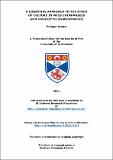Files in this item
A cognitive approach to the study of culture in wild chimpanzees (Pan troglodytes schweinfurthii)
Item metadata
| dc.contributor.advisor | Zuberbühler, Klaus | |
| dc.contributor.author | Gruber, Thibaud | |
| dc.coverage.spatial | 221 | en_US |
| dc.date.accessioned | 2012-09-20T20:35:13Z | |
| dc.date.available | 2012-09-20T20:35:13Z | |
| dc.date.issued | 2011-11-30 | |
| dc.identifier | uk.bl.ethos.556366 | |
| dc.identifier.uri | https://hdl.handle.net/10023/3101 | |
| dc.description.abstract | The question of animal culture has been of interest for decades. Chimpanzees (Pan troglodytes) have played a key role in the debate of whether or not it is appropriate to use the term ‘culture’ to describe animal behaviour and they continue to be one of the prime species for the study of the origins of human culture. Data suggesting that chimpanzees can be considered a cultural species continue to accumulate, but this has only enhanced the debate between proponents and opponents of animal culture. Opponents do not deny that behavioural diversity exists between different populations of the same species, but they maintain that such phenomena have little to do with human cultures and may be the result of genetic and environmental influences. In their view, human cultures are centred on socially shared sets of ideas, not behavioural traditions. In this thesis, my goal is to tackle this problem and to investigate whether a cognitive dimension can be found in some behavioural patterns of chimpanzees that have been put forward as examples of animal culture. To this end, I examine the different factors that could account for the development of tool use in animals (genetics, ecology, social). My first empirical contribution is a study of the tool use behaviour of the chimpanzees’ closest relative, the bonobos, which are known to be limited tool-users in the wild. I show that captive bonobos are as flexible tool-users as chimpanzees, suggesting that genetic factors are unlikely to account for differences in tool use behaviour in the Pan clade. Second, through the use of field experiments, I show that wild chimpanzees from different Ugandan communities respond to the same apparatus and task in strikingly different ways. I interpret this finding as an outcome of differences in cultural knowledge, mainly because the affordances of their immediate environment do not determine their tool use behaviour. Finally, through a broad ecological and tool use survey of different chimpanzee communities in Uganda, I show that current ecological differences are poor predictors of tool use. I conclude that, if ecology plays a role in the development of tool use, then its influence is that of a selective force. Finally, when reviewing the outcome of this research I will argue that there is a profound cognitive dimension to tool use in wild chimpanzees, suggesting that behaviourally based definitions of animal culture may miss a key feature of the phenomenon, at least in chimpanzees. Chimpanzees are not only a cultural species, they also have a cultural mind. | en_US |
| dc.language.iso | en | en_US |
| dc.publisher | University of St Andrews | |
| dc.rights | Creative Commons Attribution-NonCommercial-NoDerivs 3.0 Unported | |
| dc.rights.uri | http://creativecommons.org/licenses/by-nc-nd/3.0/ | |
| dc.subject | Wild chimpanzees | en_US |
| dc.subject | Culture | en_US |
| dc.subject | Tool use | en_US |
| dc.subject | Cognition | en_US |
| dc.subject.lcc | QL737.P96G88 | |
| dc.subject.lcsh | Chimpanzees--Psychology | en_US |
| dc.subject.lcsh | Chimpanzees|xBehavior | en_US |
| dc.subject.lcsh | Social behavior in animals | en_US |
| dc.subject.lcsh | Culture | en_US |
| dc.title | A cognitive approach to the study of culture in wild chimpanzees (Pan troglodytes schweinfurthii) | en_US |
| dc.type | Thesis | en_US |
| dc.contributor.sponsor | Leverhulme Trust | en_US |
| dc.type.qualificationlevel | Doctoral | en_US |
| dc.type.qualificationname | PhD Doctor of Philosophy | en_US |
| dc.publisher.institution | The University of St Andrews | en_US |
| dc.publisher.department | School of Psychology | en_US |
This item appears in the following Collection(s)
Except where otherwise noted within the work, this item's licence for re-use is described as Creative Commons Attribution-NonCommercial-NoDerivs 3.0 Unported
Items in the St Andrews Research Repository are protected by copyright, with all rights reserved, unless otherwise indicated.


